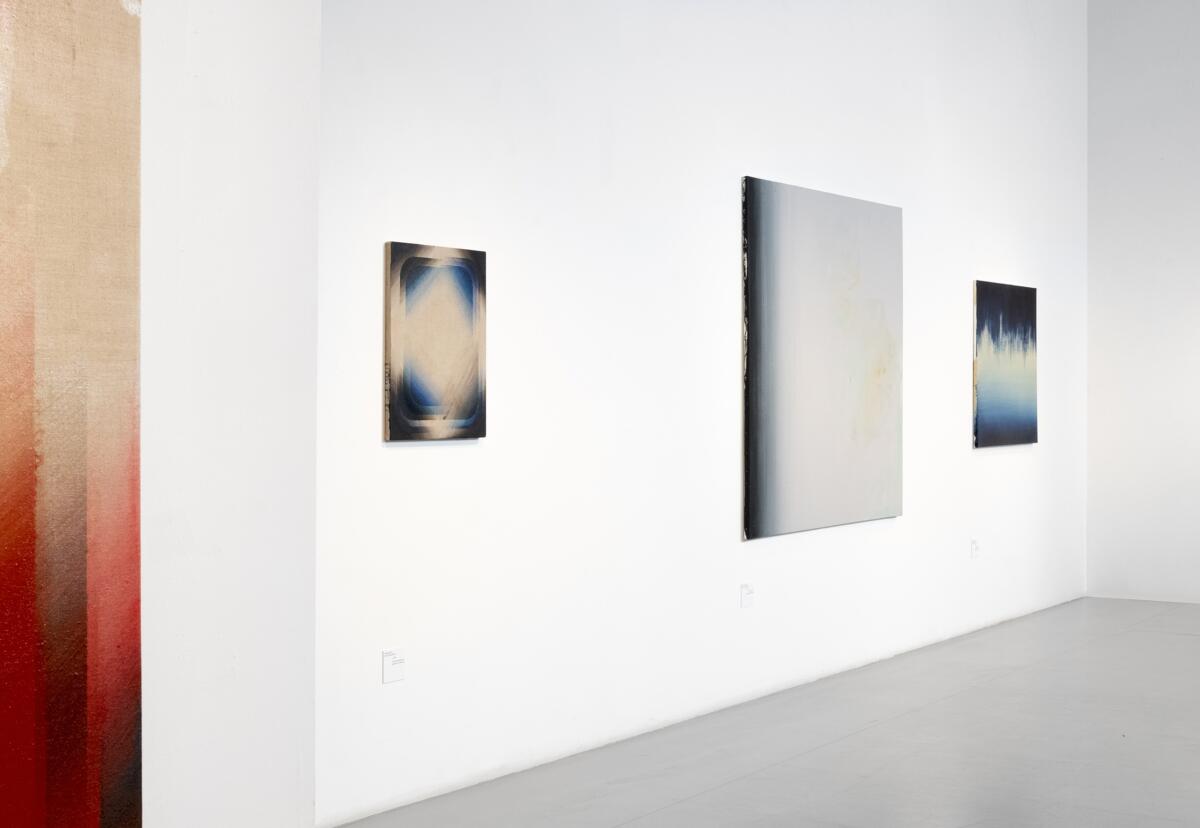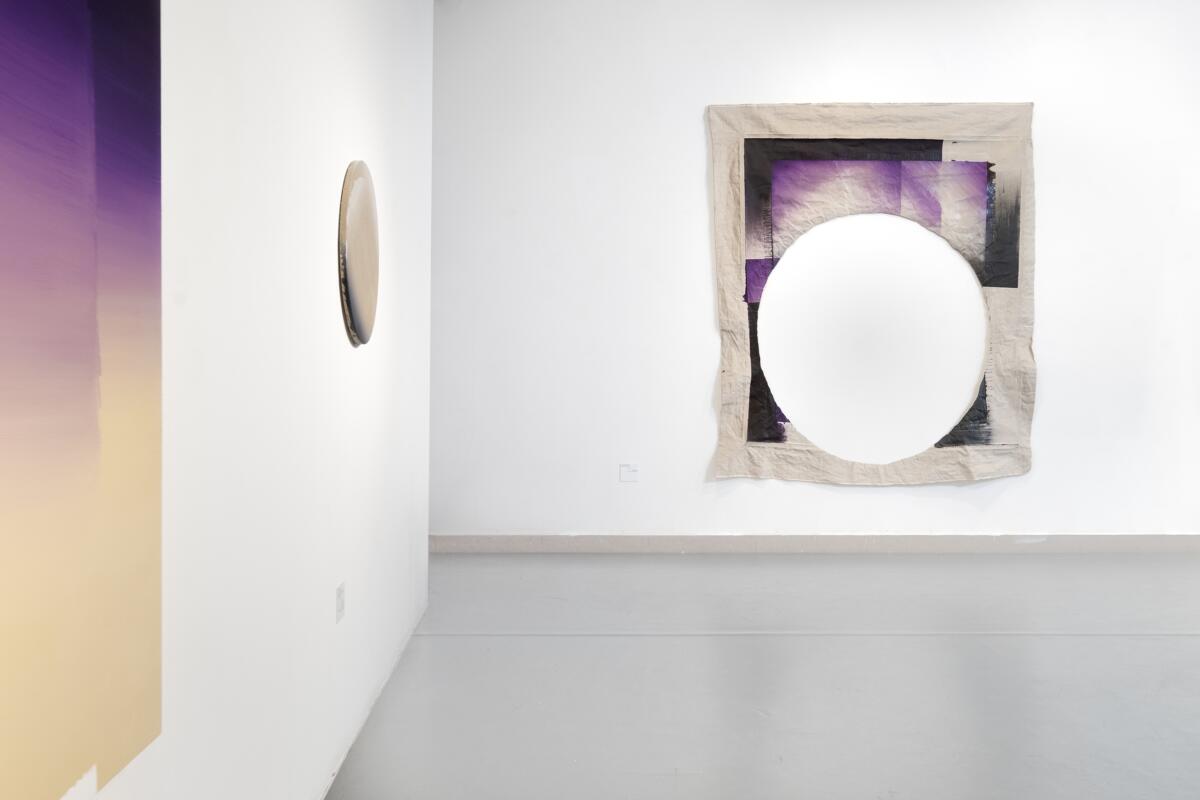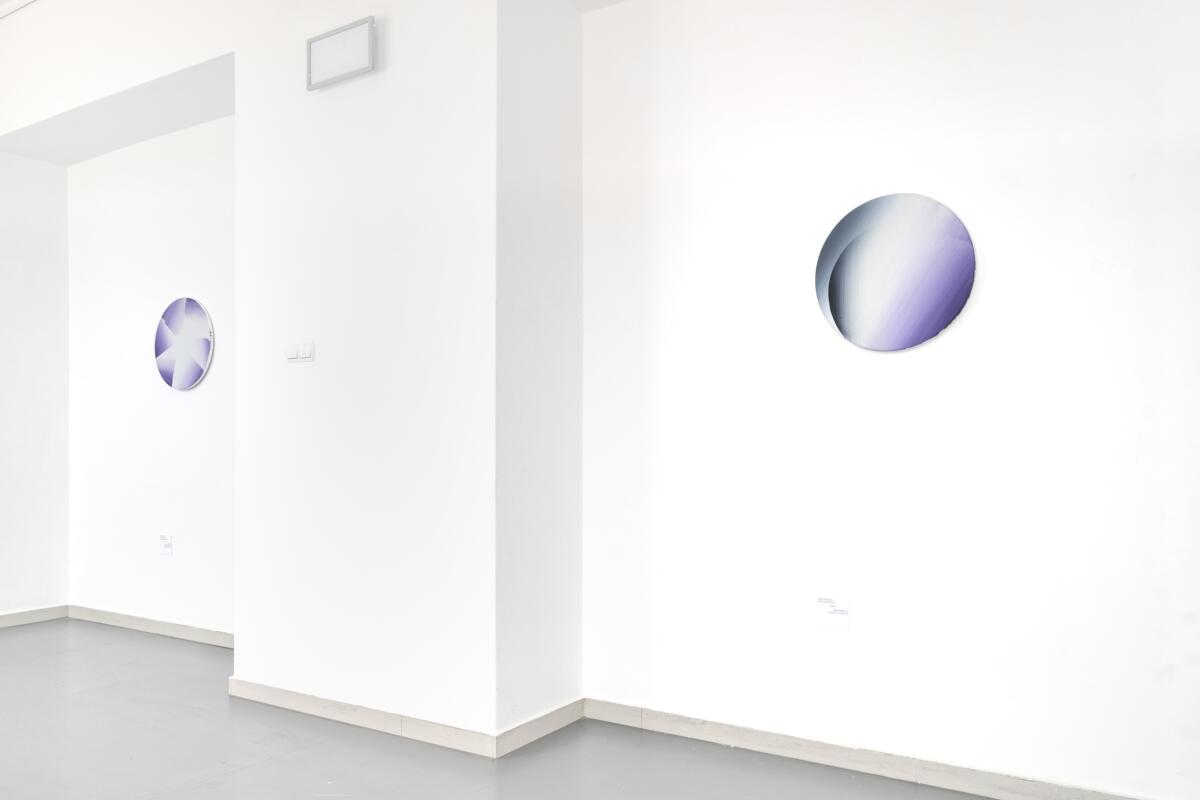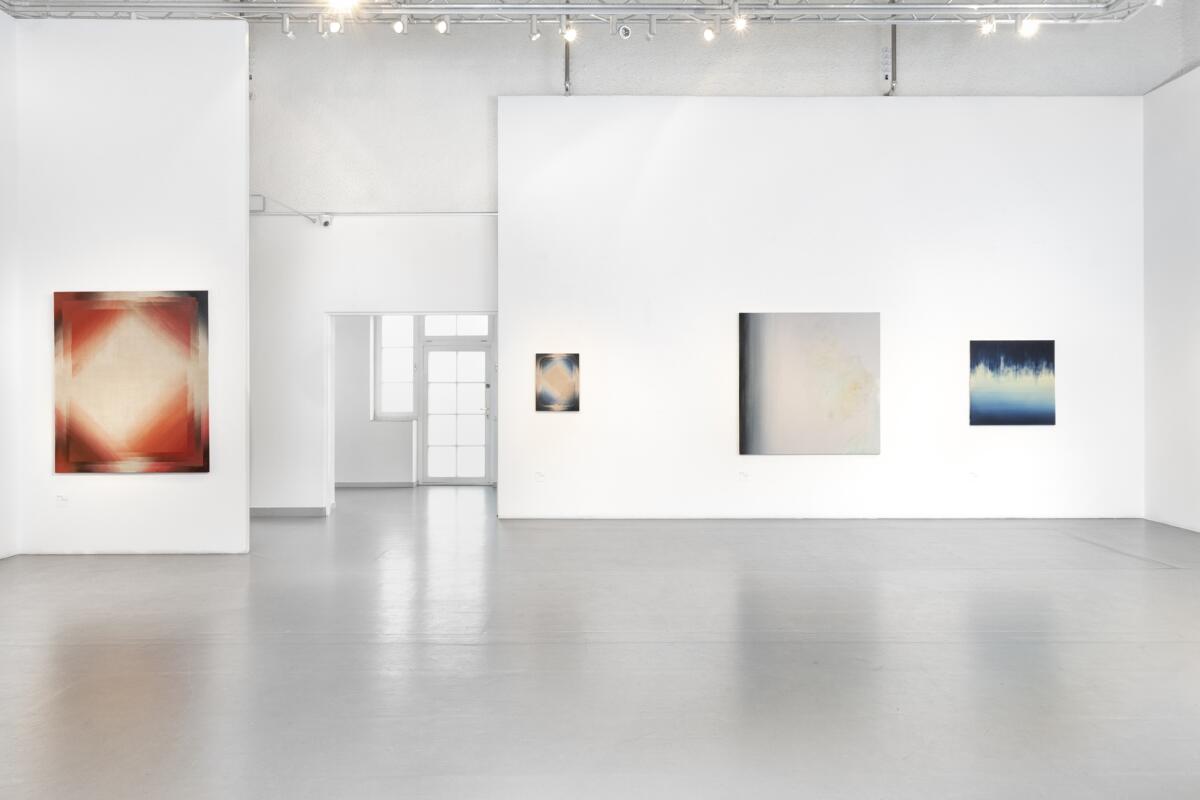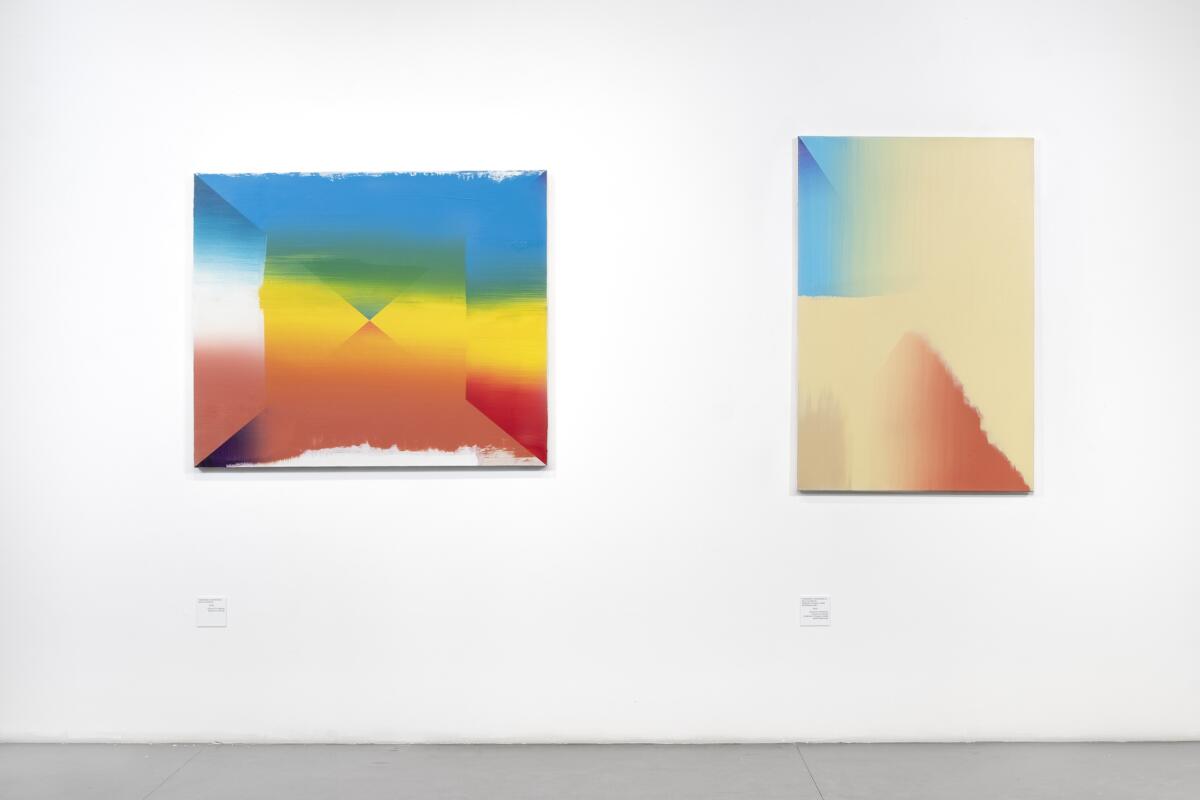
Ewa Łączyńska-Widz: The title of our exhibition, Divided View, was inspired by one of the paintings it featured. However, you can refer it more broadly to what you’re creating now.
Agata Bogacka: All the paintings shown in Tarnów are thematically integral, even though they come from several cycles. The issue they convey is always the same, which is division and inconsistency between individuals. Divided View is the largest painting at the exhibition. It shows that something could be a coherent surface, coherent organism, but there are certain differences in our worldview and opinions are that divides it. It’s a view divided by our worldviews or slight differences in them. In this painting, the gradient difference could nicely stretch across the entire canvas, but there are slight vertical shifts that disturb the surface. If we interpret the image as a view of a crowd, then you could say that this crowd of individuals moves forward and is different all the time.
Ewa: Divergence and dissonance is an immanent feature of the painting for you.
Agata: In the title, the “divided view” is every image’s characteristic, not just mine. The painting disturbs our reality, it’s a fragment of one thing that we put into another – into our reality. The picture that we hang on the wall will always divide this reality because it itself will create the division, a new reality. The act of painting itself is also a division, it’s a constant division of surface. The composition requires for the canvas to be always divided. The image speaks of division, some dissonance, maybe even disagreement.
Ewa: We first showed your paintings at BWA Tarnów three years ago, in 2018. For the exhibition The Great Sarmatian Men of This Country/The Great Sarmatian Women of This Country, the curator Marcin Różyc chose two of them. One was still figurative – it represented a woman’s legs, a piece of her body; and the other one was almost completely abstract. Now your abstract images have blurred even more, you can define them as gradient.
Agata: I try to find the right technique for myself, so that the technique itself says what I want to convey. When I adapted the gradient for myself – that is, the tonal transition, I looked for a form in which it could exist. At first, I went through various figurative images using gradients and only later shifted to complete abstraction. A gradient is a tonal transition from one thing to another. In my paintings, it blurs very gradually and imperceptibly, after which I set the boundary by cutting off another gradient, another plane. That’s the rule for my paintings – I blur the boundaries and I set them. In this way, I try to reflect the reality that surrounds me now.
Ewa: In many of the paintings selected for this exhibition we see a raw canvas. How did it come to exist in your painting?
Agata: I always rely on experiments to evolve. That’s what I do – searching. Once I came across a procedure in which the gradient can also be applied on a raw canvas. Then there was a very long series of Relationships, paintings under this title. They were all painted on a raw canvas, on which – perhaps in the best way – I could show this configuration between the planes. At all times, what is important for me is how the surfaces interact with each other in the image, because it reflects how we function in life. These planes get cut off from each other once, by changing the direction of the gradient or by sharply cutting off the planes with masking tape, or by stopping the brush. But then, somewhere, these planes meet, they somehow communicate and there occurs some agreement between them. On the other hand, these planes exist only because they get cut off from each other. Someone who has different views will be visible. The same thing happens in a relationship between two people, which I present in the picture. It would be ideal if there was agreement all the time, but it’s the difference in points of view that brings out the person, distinguishes them from one another.
Ewa: At the exhibition, we show paintings from the Relationship series. Who were you thinking of when you made them? Individual people or a crowd?
Agata: I use abstraction to get to the heart of the matter, to bring it out. It seems to me that this arrangement of planes is repeated in the same way between two people as it’s repeated in a political situation – on a completely different scale, but the principle is the same. We’re governed by people whom we have chosen to do so, and whom we pay to rule us, even though they do it in an oppressive way. It’s an interesting arrangement to repaint, to show it in an abstract way. One surface rises above the other, overwhelms it, while on the other hand it arises from the weaker one.
Ewa: Let’s talk for a moment about the colors you choose. You seem to have a lot of color awareness.
Agata: It seems to me that this is rather unconscious. I could close my eyes and choose the color I want to paint with. I often choose a color that is difficult for me at a given moment. I choose it because as I work on it and face the image, I face the situation that surrounds me. I don’t want color to make things easy for me, rather to make it difficult, because in general, it’s rather difficult.
Ewa: Why violet?
Agata: Violet is very interesting to me. It looks as if it’s created from two colors, red and blue, and this is one natural pigment, an original color, without admixtures. It’s rarely used. It has – unlike red – the shortest range of visibility. When I use violet, I think about closeness, but also about the lack of distance. When I used it, I was referring to a demonstration where people are pressured. At the exhibition, we have a few violet paintings from the Relationships series. Using it in these images, I was thinking about closeness in a relationship, but you can also use two opposite terms – closeness in a relationship and lack of distance.
Ewa: And how do you perceive the color blue?
Agata: Blue is too pleasant for me. When I use it, I often try, through the appropriate form, to disrupt its pleasure.
Ewa: In Equality Dream, we can see many colors.
Agata: These are the only paintings in the exhibition in which the colors are a quotation. I wanted to make a reference to the LGBTQ+ flag, but at the same time claim it back, by trying to touch each color to every other one, hence the connection in the middle. It’s an attempt to build some kind of arrangement. On the one hand, this image disrupts the flag, and on the other hand, it’s trying to build it anew. It’s a constant battle for rights, for equality. The dream of equality.
Ewa: There are dreams. There are also paintings from the Promises series.
Agata: Promises are a formal procedure – again a characteristic of this gradient that speaks for itself. A promise is something that has a very clear beginning, then it blurs and never comes to fruition. The beginning of the gradient is clear, then it blurs and finally disappears, like an unfulfilled promise.
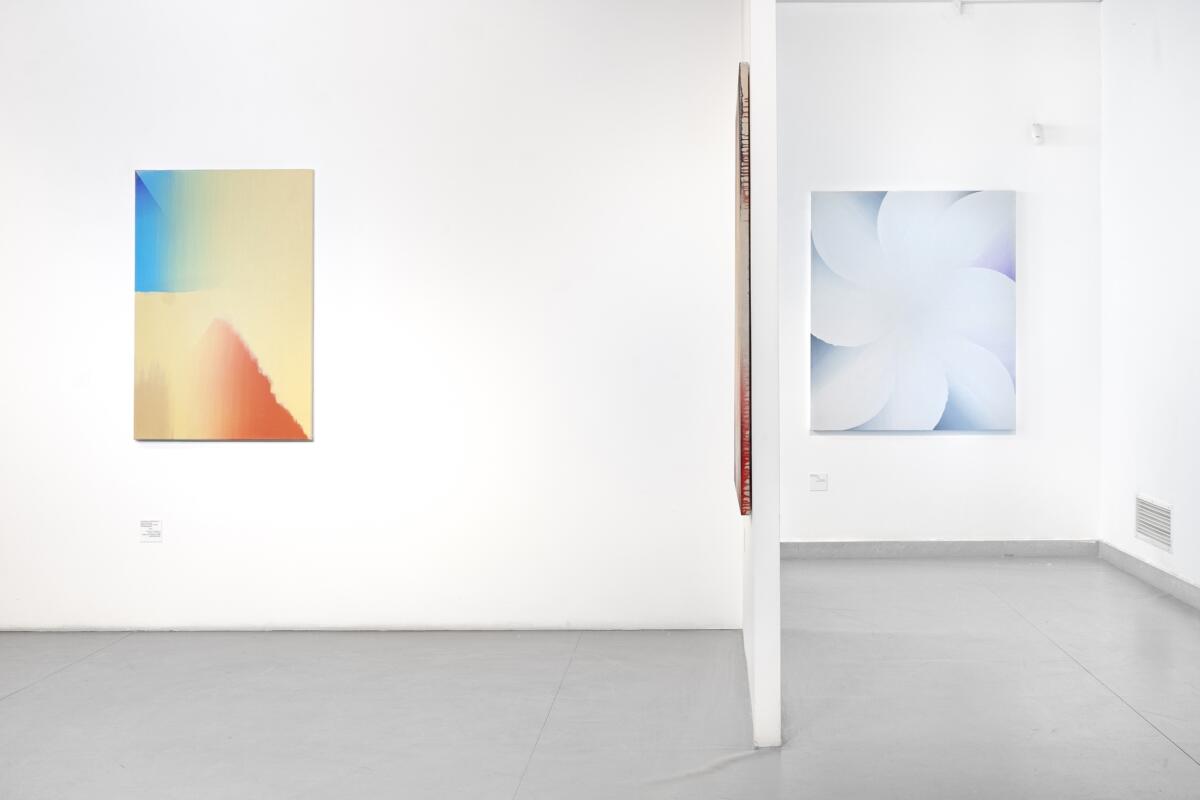

Ewa: What are these promises?
Agata: Any of them. I’m dealing with a lot of broken promises.
Ewa: We also present a very interesting thing. A canvas after the cut out image Roots.
Agata: This image has changed format several times. I took the canvas off one loom, painted it, put it on another, smaller one, and so on several times. The last format, I cut out and stretched on a round loom. I was left with a canvas with a hole in the middle, on which are the remains of previous versions of the painting. I’ve decided to show it at our exhibition, too. The roots extend beyond the image. And here I give the title Absence, about what is not.
Ewa: In the earliest painting shown at the exhibition – Untitled from 2016 – we see a spot that still evokes some shape.
Agata: It’s an early painting, so it didn’t function as “mine”. Now you can freely put it in what I do. When it was created, it was different from what I was doing. I didn’t paint abstractions then.
Ewa: What is the form seen in this painting?
Agata: These are the remnants of the previous layers because this is how I usually work. I try not to plan paintings. It’s best when I don’t really do it at all, I just paint through my daily reaction to an image. I go into the studio; I look at the painting and I keep painting. Then I am a relay of the world, I intuitively reflect in the image something that is currently happening. I reflect the situation I find myself in, and it changes every day. Responding to the image on a daily basis is the best method.
Ewa: So are your paintings notebooks, diaries?
Agata: It’s a process. A painting is a piece of a process. We see in the exhibition some preserved version of this process, although this picture actually takes place exactly at the same time as the painting process. Maybe even showing the painting in an exhibition is somehow unnatural to it because it continues in time, and here it’s suddenly stopped.
Ewa: Was the choice of an abstract form of images – which definitely differs from your images that we know from years ago – your decision to isolate yourself from that period of time? Was it – to paraphrase your system of work – a gradient transition or was it drawing the line?
Agata: I closed my earliest figurative period at some point because I thought that this painting project was finished. I had no need to duplicate nor carry on with it. I began to look for something else, a new means of expression. In the beginning, these were very different images. The search and development of new techniques, expressions, led me to this quite abstract form in which I am now.
Ewa: Do you feel that over time it will evolve into a completely different form? Do you think it will stay with you much longer?
Agata: It’s very likely that someday this will change, it will cease to be enough for me. That’s in my nature.
Ewa: How do you see the role of artists? Who are you, an interpreter of what you observe?
Agata: I observe what surrounds me, I observe the political situation, and based on it, I try to figure out the human interaction. I think that an artist is someone who doesn’t accept the answers. When they have an answer, they ask the question, which constantly reverses the situation.
Ewa: What you experience appears in your paintings. What you see around you, you pour onto the canvas. What do you want these paintings to give viewers?
Agata: I would not emphasize myself here, that this is my experience. That’s why I got rid of the figuration, so that it wouldn’t be a story about me, but about people in general, about everyone. Anyone will find themselves in this situation. At first, these images make a pleasant impression, they are attractive. The longer you interact with them, the more uncomfortable you begin to feel, because their composition speaks of dissonance and grime with which we collide on a daily basis. It’s like living a life that seduces us all the time and then fails us.
Ewa: Can this change? Is there a recipe to make it better?
Agata: I think our assumptions are wrong because the question about the meaning of life constantly arises, and maybe we should assume that life doesn’t have to have meaning and that this lack of meaning can be its basis. Then what we do is a completely different story.
Warsaw – Tarnów, April 2021
Imprint
| Artist | Agata Bogacka |
| Exhibition | Divided View |
| Place / venue | BWA Tarnów |
| Dates | 7-23 May 2021 |
| Curated by | Ewa Łączyńska Widz |
| Photos | Bartosz Górka |
| Website | www.bwa.tarnow.pl/ |
| Index | Agata Bogacka Ewa Łączyńska-Widz |

